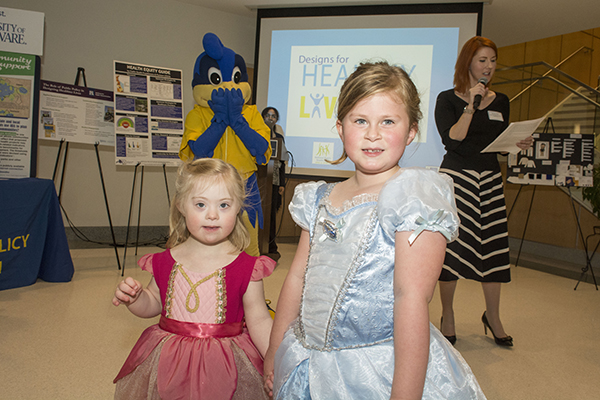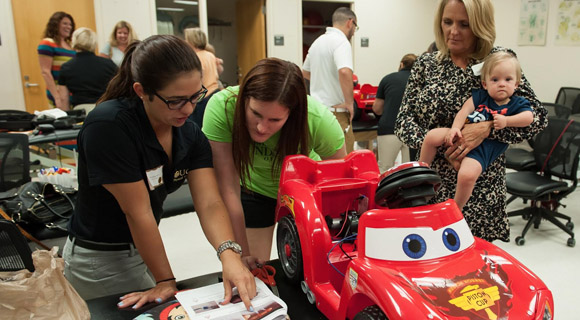And then, one afternoon in Orlando, she was moving—and she was moving fast.
“She was just out loud laughing and giggling,” said Kay Bowman, Ava’s grandmother. “She just couldn’t get enough of it. I was in tears.”
In May, members of the University of Central Florida’s physical therapy faculty joined GoBabyGo, a University of Delaware-based mobility research and development team, to purchase toy ride-on vehicles and retrofit them for children with special needs.
Ava was one of those children.
Ava was two days overdue when her mother died suddenly, leaving her without oxygen for an hour.
The doctors said she wouldn’t make it through the night but Ava, “the miracle baby,” survived.
The experience left her with cerebral palsy, a disorder that affects muscle tone, movement and motor skills.
A lack of oxygen during birth is one of the causes.
Thankfully, in most cases, including Ava’s, intelligence levels are not affected.
“She’s a smart little girl; she just can’t talk or sit up yet,” grandfather Rodney Brown said. “You can tell she wants to. You can hear her grunting, trying, but she physically can’t.”
And that’s where GoBabyGo came in.
Bowman was reading a copy of Woman’s Day magazine when she came across an article about the program. After a little more digging, she found that Cole Galloway, founder of the program, would be at UCF in May, helping to get cars built for kids in Florida who needed them. She reached out to Jennifer Tucker, a member of the UCF physical therapy faculty who helped spearhead the event.
Tucker said Ava’s family and 10 others showed up for the workshop. Each left with his or her own, personalized motorized car.
“The focus of the research is bringing innovative and accessible tools for mobility to children with impairments,” Tucker said. “This work is so important because it offers a fun, innovative, accessible way to promote mobility in young children – there is not an avenue in current health care that offers this mobility.”
The cars at the workshop, complete with all the necessary components— which are nothing more than PVC pipe, pool noodles, boogie boards and some re-worked wiring— were given out free of charge and the families of the children took part in the building process.
Rodney Brown finished Ava’s car in a matter of hours and the family stood by expectantly as she was buckled in.
“We weren’t sure if she was going to get it,” Ava’s aunt, Katie Wibirt, said. “But it took her like 10 seconds.”
In Ava’s car, the pedals were removed, and a dinner plate sized red button on the steering wheel now acts as the gas.
“As soon she pressed that button, her face lit up,” Brown said. “She realized she could go on her own and she just went.”
“And she’ll just go and go until she hits something.” Wibirt added, smiling. “We had to install a kill switch.”
PVC pipe wrapped in a pool noodle surrounds the cab to prevent her from falling out or hitting the hard plastic sides and a boogie board attached to the backrest of the seat adds extra support. These two things plus the aftermarket seatbelt turns Ava’s toy into a therapeutic device.
“Ava cannot get therapy; there is no one that will fund therapy for her every day of the week,” Tucker said “But if she has sensory motor exploration every week, that opens doors – she becomes the driver of her own destiny.”
The car offers that exploration without the price tag typically attached to motorized wheelchairs, “plus there’s a stigma that comes with having the big, bulky chair …. People just stare,” Bowman said.
“He’s (Galloway) not doing it for the money. He doesn’t even have a patent.”
All of the instructions are available online and everything you need to construct one can be bought at Toys-R-Us and The Home Depot— $300 compared to tens of thousands.
“The crux of Dr. Galloway’s work is that accessibility,” Tucker said. “It’s cheap and very easy. It only takes an hour and a half and the impact can reach across a life span.”
And Galloway makes sure that he and his people are readily available for anyone needing help along the way.
“I’ve gone on Facebook and messaged their page and they are more than happy to respond,” Wibirt said. “And if you come with an innovation on your own that helps your child, something he hasn’t encountered, he wants that.”
Galloway said it’s that kind of innovation that initially sparked GoBabyGo and continues to play a pivotal role.
“It stemmed from doing National Science Foundation research,” Galloway said. “We had data showing that kids could drive mobile robots…. but robots were never going to get out and I don’t think it’s ethical to dangle something like that.”
At that time, Galloway’s research revolved around small robotic devices, but the machinery was very pricey and complex.
“Finally that got to me; six months later I was going around and talking about this. I finally woke up and said, ‘Look, we have to stop this work or find a low cost solution.’ We went to Toys-R-Us.”
Jeremy Brown, Ava’s Dad, said he can see the change taking place in his daughter.
“We take her on walks, get her outside,” he said. “She can’t quite steer yet by she’s learning. She loves it.”
And that, Galloway says, is the key to all of this—the fun factor.
“Play for kids is work,” he said. “Play encompasses everything. She can increase her function while she is participating with peers, while she is learning.”
“Ava needs to, at the very least, be independently mobile; she should be able to go where she wants to go when she wants to go. That’s a human right – we are talking about providing humans on the planet with what we have all agreed on is a basic need.”
Tucker said UCF has another workshop tentatively scheduled for December. For more information, e-mail her at jennifer.tucker@ucf.edu.
[ Clifford Parody can be contacted at clifford.parody@theledger.comor 863-802-7550. ]


 UCF Provides Modified Kiddie Cars to Special Brevard Toddlers
UCF Provides Modified Kiddie Cars to Special Brevard Toddlers